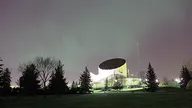The Visible Planets
Mercury is not visible for most of the month as it reaches superior conjunction on February 9. However, it starts to become visible again extremely low above the western horizon after sunset around February 23, gaining some elevation in that part of the sky by the end of the month. After sunset on February 24, look for Mercury near the planet Saturn low in the western sky. Then, after sunset on the evening of February 28, see if you can find Mercury near the very slim waxing crescent Moon.
Venus continues to shine brilliantly in our southwestern sky after sunset, setting about 3-hours later along the northwestern horizon. On February 1, look for Venus just above the slim waxing crescent Moon with the much fainter planet Saturn well below both. On this same night, if you have a telescope, the planet Neptune can be found near Venus and the Moon as well.
Mars shines brilliantly all night long, rising above the northeastern horizon around sunset, moving high across the southern sky through the night, and then setting along the northwestern horizon by sunrise. Mars can be found shining brightly amongst the stars of the constellation of Gemini, the twins, all month long. Look for Mars near the waxing gibbous Moon on the evening of February 9. For the early part of February, Mars continues its retrograde (westward) motion amongst the stars of Gemini, but on February 24, Mars becomes stationary and then resumes its prograde (eastward) motion afterwards. Through February, Mars continues to dim in brightness as the distance between Mars and the Earth increases. Consequently, early February would be your best time to view Mars through a telescope to see surface features at their best!
Jupiter continues to shine brightly amongst the stars of the constellation of Taurus, the bull. Look for Jupiter above the orangey-red bright star, Aldebaran, the “eye of the bull”. On February 6, Jupiter can be found near the waxing gibbous Moon through the night. Jupiter still provides some exceptional telescopic viewing this month and will be a highlight of our regular Friday and Saturday night openings of the RASC/TWOSE observatory (weather allowing).
Saturn is seen with difficulty low above the west-southwest horizon after sunset at the start of the month. However, it quickly sinks lower and disappears into the twilight glow by mid-month.
Moon Phases
February 5 First Quarter Moon
February 12 Full Moon (The Snow Blinding Moon)
February 20 Last Quarter Moon
February 27 New Moon
Special Events
International Space Station (ISS) Observable Passes
- Look for passes of the International Space Station in the early evening sky on February 1. There are no visible passes from February 2 to February 11; however, from February 12 till March 5, the ISS can be found passing overhead in the predawn hours. The exact times of these passages for your location can be found by visiting the website http://www.heavens-above.com or by using satellite tracking smartphone apps like Sputnik or Spot-the-Station.
February 1: Very sad 22nd Anniversary of the loss of the Shuttle Columbia and its Crew (2003).
February 2 Groundhog Day
February 9 Mercury is at superior conjunction.
February 10 Royal Astronomical Society of Canada (RASC) Edmonton Centre meeting
- Live in the Zeidler Dome at TWOSE and presented virtually through Zoom. 7:30 p.m. – 9:30 pm. It is free for anyone to attend. See http://www.edmontonrasc.comfor more details.
February 14, Valentine’s Day
Venus at its brightest at magnitude -4.9!
February 17 Family Day holiday
February 18 Clyde Tombaugh’s discovery of Pluto 95 years ago (1930).
February 28: First day of Ramadan (begins at sunset tonight).




